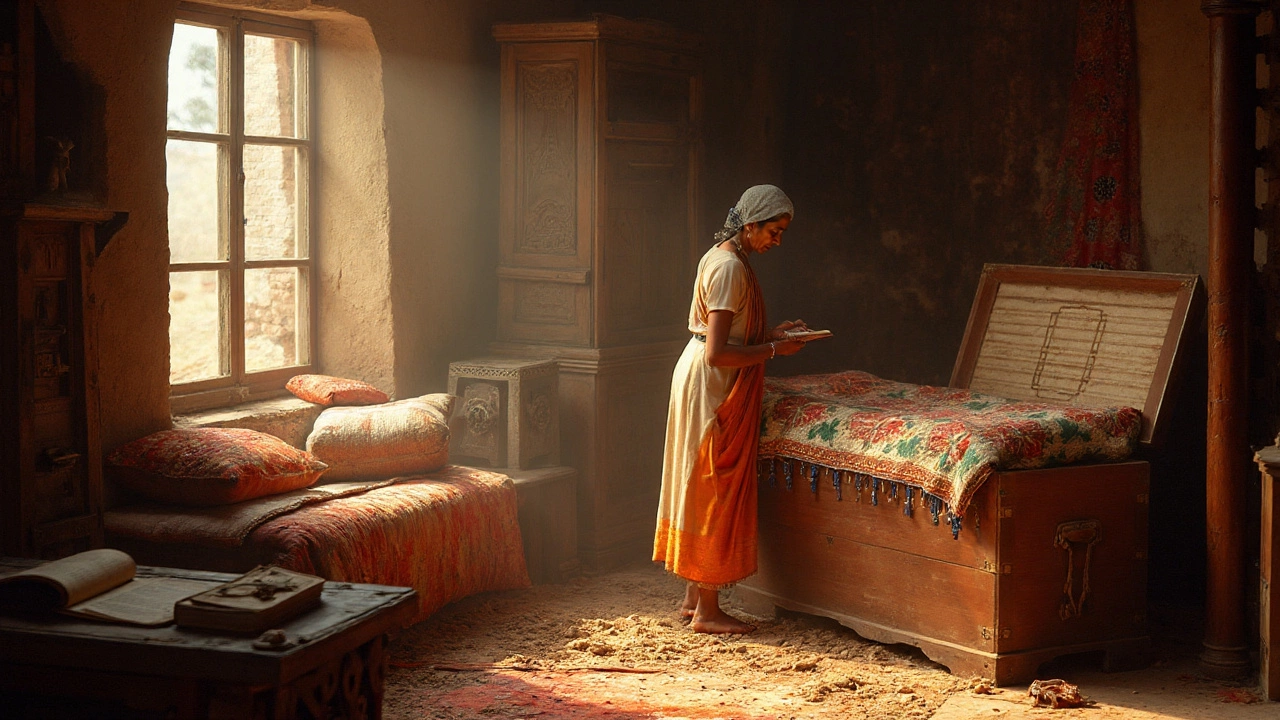Bedding didn’t always mean a matching doona set from a catalog. In older English, it was the stuff you slept on and under-often straw, a tick, blankets, and quilts-plus the animal litter in the barn. If you’re reading a will, a farm diary, or a 19th‑century ad and you spot “bedding,” that single word can carry more than one meaning. Here’s the short, clear answer you probably came for-and the guardrails to use it correctly in your research or writing.
- TL;DR: Historically, “bedding” meant bedclothes and bed-stuff (e.g., straw, tick, blankets, quilts) for people; also the litter for animals.
- By the mid‑1800s, gardeners used “bedding” for massed seasonal plantings (“bedding plants”).
- In geology, “bedding” is the layering of sedimentary rock (“bedding planes”), a 19th‑century technical sense.
- In old inventories and ads, “bed” (the frame) is listed separately from “bedding” (the soft goods).
- To interpret any instance, check context: house vs barn, garden vs quarry, and what other items sit around the word.
What “bedding” meant in older English
If you’re after the old meaning of bedding, think simple and practical: the materials that made a bed comfortable, plus the coverings on top. In household records from the 1500s to the 1800s, “bedding” usually included a straw- or feather-filled mattress (often called a “tick”), blankets, a coverlet or quilt, sometimes bolsters and pillows, and occasionally a canopy or hangings if it was a curtained bed. It did not mean the bed frame. That’s why older documents often list “bedstead” or “bed” on one line and “bedding” on another.
The Oxford English Dictionary (OED) traces the domestic sense back to Middle English: essentially “the materials forming a bed” and “bedclothes.” Merriam‑Webster keeps it short: “bedclothes” and “material for a bed.” The everyday takeaway is that an appraiser or probate clerk in 1700 would have looked at the soft pile-the tick, the blankets, the quilt-and grouped those as “bedding,” while the timber posts and rails were “bed.”
There’s a second long‑standing domestic meaning you’ll see in farm books and diaries: “bedding” as the covering laid down for animals-straw or other absorbent matter spread in stalls. So when a farmer writes, “Set fresh bedding for the cows,” that’s not about quilts; it’s about straw and comfort (and cleanliness) underfoot. Both senses-human bed-stuff and animal litter-run in parallel for centuries. Context is your compass.
Three quick distinctions that keep you out of trouble:
- Bed vs bedding: the frame and structure vs the soft goods. If a record lists both, “bed” is timber; “bedding” is textiles and fillings.
- Linen vs bedding: “linen” often means sheets, pillowcases, and tablecloths. “Bedding” includes the bulkier, stuffed, or woollen items-ticks, blankets, quilts. Sheets might sit under “linen” or under “bedding,” depending on the clerk and period.
- Human vs animal: household chamber vs barn/stable context. Simple cue: if cows, stalls, or mucking are mentioned, it’s animal litter.
How the meaning shifted: a quick timeline across fields
Words travel. Here’s how “bedding” branched into different domains while keeping its roots.
Middle English to 18th century (domestic core): The OED shows “bedding” in the sense of bed-stuff and bedclothes from the 1300s onward. In probate inventories across Britain and Ireland (and later the colonies), appraisers regularly list “one bedstead and bedding,” with bedding valued based on feather content, blanket count, and condition. In these lists, sheets are sometimes filed under “linen” separately.
Early modern to 19th century (animal husbandry): Farming manuals and estate accounts use “bedding” for straw and litter. The usage is consistent: “cart straw for bedding,” “spent bedding from stalls.” If a ledger talks about “straw for bedding” next to entries for chaff and oats, you’re in barn territory.
Early 19th century (geology): As geology formalized, “bedding” took on a technical meaning: the layered arrangement of sedimentary rocks and the planes between those layers (“bedding planes”). Geological Society of London glossaries and 19th‑century textbooks made this standard. If you see “bedding plane,” “cross-bedding,” or “strike and dip,” you’re not in the bedroom anymore.
Mid‑19th century (horticulture): “Bedding out” became the rage in Victorian gardens-mass planting of brightly colored annuals in geometric beds. Gardeners still speak of “bedding plants” (think petunias, salvias, begonias). The Royal Horticultural Society’s manuals anchor this sense. In Australian newspapers digitised by the National Library’s Trove, 1860s-1890s adverts for seeds and “bedding plants” are common, right alongside separate ads for “beds, bedding, and bedsteads.” Two spheres, one word.
20th to 21st century (retail packaging): Modern retail uses “bedding” for consumer sets-duvet covers, sheets, pillowcases, mattress toppers. That’s the broad, lifestyle sense most of us know today. But in historical documents, assume the leaner, more literal meaning unless the context screams otherwise.
Dates at a glance:
- c. 1300s: Household “bedding” = materials forming a bed; bedclothes (OED).
- 1600s-1800s: Parallel use for animal litter in farm contexts.
- Early 1800s: Geology adopts “bedding” for rock stratification.
- Mid‑1800s: Horticulture popularizes “bedding plants” and “bedding out.”
If you write historical fiction, family history, or antique catalog notes, the safe rule is to pick the sense that matches the setting and the neighboring words. Bedroom? Bedclothes. Stall? Straw. Quarry? Layers. Garden? Annuals.

How to read “bedding” in old records, ads, and literature
When you bump into “bedding” in an old text, here’s a simple, repeatable way to decide what it means-without second‑guessing yourself.
- Scan the neighbors. What sits on either side of the word? If you see “bedstead,” “curtains,” “chamber,” or “linen,” you’re in a bedroom inventory. If you see “stable,” “stalls,” “straw,” “manure,” or “cows,” it’s animal litter. If “beds,” “borders,” “annuals,” or “carpet bedding” appear, that’s horticulture. “Strata,” “sandstone,” “plane,” “strike/dip” signal geology.
- Clock the date and place. Pre‑1900 household lists in Britain, Ireland, or the colonies (including Australia) use “bedding” in the older domestic sense. By the Victorian era, you’ll also see garden uses. Scientific journals from the 1800s favor the geological sense.
- Watch for pairings. Phrases like “bed and bedding,” “bedstead and bedding,” or “beds, bedding, and bedsteads” are common in probate and shop ads. The frame is separated from the soft goods on purpose.
- Check the linens. If a list separately has “linen,” it may hold sheets and pillowcases, while “bedding” covers the bulkier pieces (tick, blankets, quilts). Some clerks toss sheets under “bedding,” so don’t force a rule-note the list logic.
- Triangulate with a period dictionary. For precise projects (a thesis, a museum tag), confirm with the Oxford English Dictionary, Merriam‑Webster Unabridged, or a date‑appropriate glossary. For gardening, the Royal Horticultural Society’s manuals are reliable; for geology, check a Geological Society glossary.
Common pitfalls to avoid:
- Assuming “bedding” includes the bedframe. It usually doesn’t.
- Forgetting the animal‑litter sense in farm contexts.
- Folding “linen” into “bedding” without checking how the record groups items.
- Over‑modernizing. A 1790s “bedding” list won’t mention a “duvet”-you’ll see blankets, coverlets, quilts.
Quick valuation clue for antiques and probate work: in 17th-19th century records, a “feather bed” (i.e., a tick filled with feathers) plus bedding could be one of the more valuable household lines after major furniture. A list that reads “1 feather bed and bedding” is telling you there’s substance there-literally weight and cost.
Australian context tip: If you’re searching Trove (National Library of Australia), try both “bedding and bedsteads” and “bedsteads and bedding.” Colonial ads often grouped frames and soft goods but priced them separately. You’ll also see garden notices for “bedding plants” in the same papers-don’t mix the two.
Examples, quick checks, and your mini‑FAQ
Examples you can trust help cement the senses. Here are realistic scenarios-with the right read in plain English.
- Estate inventory, 1784 (England): “In the Best Chamber: one bedstead, feather bed, and bedding.” Meaning: the bed frame (bedstead) is one item; the feather‑filled mattress (“feather bed”) and the rest of the bedclothes (blankets, quilt) are grouped as “bedding.”
- Shop advertisement, 1862 (Melbourne): “Beds, Bedding, and Bedsteads at Reduced Prices.” Meaning: retail categories; “bedding” is quilts, blankets, mattresses/ticks, bolsters-sold separately from frames.
- Farm diary, 1877: “Spread fresh bedding in the cow house.” Meaning: straw or similar litter for animals.
- Geology note, 1891: “Cross‑bedding visible in the sandstone at the quarry face.” Meaning: inclined layers within sediment beds-purely geological.
- Garden guide, 1888: “Bedding plants for summer display: geraniums, lobelia, and alyssum.” Meaning: massed seasonal planting for color blocks.
Cheat‑sheet: a 10‑second decision tree
- Seeing “bedding” near “bedstead,” “chamber,” “linen”? Read it as bedclothes and bed-stuff.
- Seeing “bedding” near “straw,” “stalls,” “cows”? Read it as animal litter.
- Seeing “bedding” near “plants,” “borders,” “carpet,” “annuals”? Read it as bedding plants/gardening.
- Seeing “bedding” near “plane,” “strata,” “sandstone,” “cross‑”? Read it as geology.
Mini‑FAQ
Does “bedding” in a 1700s household list include the mattress?
Usually yes, if the mattress is a stuffed “tick” (feather or straw). Many lists say “feather bed” for the filled tick and group it with “bedding.” The wood frame stays separate as “bed” or “bedstead.”
What’s the difference between “bedding” and “linen” in old records?
“Linen” often means flat textiles-sheets, pillowcases, tablecloths-especially if they’re flax. “Bedding” is the bulk: mattress/tick, blankets, quilts, bolsters. Some clerks do put sheets under “bedding,” so read the whole list, not just the headings.
When did gardeners start saying “bedding plants”?
Mid‑19th century with the Victorian “bedding out” craze. Manuals and garden columns from the 1850s-1880s are full of it. The Royal Horticultural Society later standardized the usage.
How old is the geological sense?
Early 1800s as geology matured. You’ll see “bedding planes,” “cross‑bedding,” and “bedded sandstones” in 19th‑century texts and Geological Society glossaries.
Is modern retail “bedding” wrong for history writing?
Not wrong, just broad. If you’re writing about 1750, swap “doona” for “blanket” or “quilt,” and remember that “bedding” then was a practical pile, not a coordinated set.
What sources back these meanings?
Primary dictionaries like the Oxford English Dictionary and Merriam‑Webster Unabridged for definitions and dates; Royal Horticultural Society publications for the garden sense; Geological Society glossaries for the rock sense; probate inventories and shop ads for lived usage. Australian examples are easy to find in Trove’s digitised newspapers.
Next steps and quick troubleshooting
- Genealogy or probate work: When an inventory lists “bed and bedding,” transcribe them as two line items. Note if “linen” is separate. If you need to explain the term, a short footnote-“bedding = mattress/tick, blankets, quilt”-keeps future readers on the same page.
- Antiques/decor writing: If you’re cataloging a four‑poster, write “bedstead” for the frame. Reserve “bedding” for the soft ensemble. If the piece includes original hangings, specify them-they’re not always counted under “bedding.”
- Historical fiction: Use period‑correct names (feather bed, tick, bolster, blanket, quilt). Save “duvet” and “comforter” for 20th‑century scenes onward.
- Garden content: Clarify “bedding” as a planting style. Readers sometimes assume “beds” = raised beds; “bedding” is about seasonal displays, not necessarily raised boxes.
- Geology study notes: Pair “bedding” with “planes,” “lamination,” and “stratification.” Sketch a simple cross‑section; visual memory locks the meaning faster.
If you’re stuck on a tricky example, ask three questions in order: 1) What is the setting-room, barn, garden, or outcrop? 2) What are the neighboring nouns? 3) How does this document group related items elsewhere (e.g., is there a separate “linen” section)? Nine times out of ten, that sorts the sense in under a minute.
Finally, a quick writer’s tip: if you need to avoid ambiguity in modern prose, specify the sense and move on-“bedding (blankets and quilt),” “fresh straw bedding for the stall,” “bedding plants for the summer border,” or “bedding planes in the sandstone face.” One noun, many lives. Context is the key that keeps them tidy.
